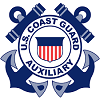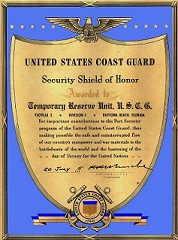FLOTILLA 44 HISTORY

A
BRIEF HISTORY OF THE U.S. COAST GUARD AUXILIARY AND FLOTILLA 44
Celebrating 80 years of service to the citizens of Florida and the United States
The United States Coast Guard Auxiliary is the uniformed civilian component of the United States Coast Guard. It was established by Congress on June 23, 1939.
Flotilla 44 Daytona Beach was chartered December 18, 1941 after an attack on America. It helped preserve, protect and defend the rivers and shores of Florida during World War Two as a temporary reserve unit.
With the prospect of war approaching, Congress deemed it necessary to augment the U.S. Coast Guard with a civilian reserve force. On June 23, 1939, Congress passed Title 14 of the United States Code establishing the U.S. Coast Guard Reserve. This organization would be administered by the Commandant of the U.S. Coast Guard, and composed of unpaid, volunteer U.S. citizens who owned motorboats or yachts. In 1941, Congress created a military Coast Guard reserve, renaming the volunteer Coast Guard Reserve the U.S. Coast Guard Auxiliary.
Title 14, United States Code (U.S.C.) contains the laws of a general and permanent nature about the Coast Guard. The original Title 14, USC, Section 822 stated: "The purpose of the Auxiliary is to assist the Coast Guard:
(1) to promote safety and to effect rescues on and over the high seas and on navigable waters;(2) to promote efficiency in the operation of motorboats and yachts;(3) to foster a wider knowledge of, and better compliance with, the laws, rules, and regulations governing the operation of motorboats and yachts;(4) to facilitate other operations of the Coast Guard."
Flotilla 44, Daytona Beach, (7th CG District) originally called Flotilla 13, is one of the oldest Coast Guard Auxiliary flotillas in the United States. Although it officially is Flotilla 4, current procedures require that a flotilla be identified not only by its flotilla numerical designation, but also with its division numerical number. The division number precedes the flotilla number. Thus, Flotilla 44 is actually the fourth flotilla, in the fourth division. The original designation was the third flotilla in the first division.
As a result of Auxiliary expansion, the flotilla was ultimately renamed Flotilla 44. New procedures now require the placing of the geographical designation after the flotilla number. This geographically identifies a particular flotilla. There could be multiple Flotilla 44's, but only one Flotilla 44 Daytona Beach.
The forming of an Auxiliary unit in Daytona Beach was first discussed in 1939 or 1940 between Dana Bowen and J. Minor Ewing. Mr. Bowen would go on to become the first flotilla commander, and Mr. Ewing the first flotilla vice commander.
Lieutenant Commander G.A. Littlefield, U.S.C.G., Jacksonville, was assigned to form the unit and inspect the first facilities. On December 12, 1941, five days after the bombing of Pearl Harbor and the entrance of the U.S.into World War II, fifteen local individuals and some from New Smyrna Beach, took the qualifying exams. They all passed. Flotilla 13 (now Flotilla 44) was officially established. It was formally chartered on 18 December 1941.
With the United States at war, the Coast Guard was temporarily assigned to the War Department (now called the Defense Department), and was under the jurisdiction of the Department of the Navy for
the duration of the war. (The Coast Guard, or select units therein, is always transferred to the Department of the Navy during times of war.) With a good portion of Coast Guard ships and crews assigned to the Navy overseas, the coastline of the continental United States was in need of additional manpower and patrol vessels.
In January 1942, German submarines had arrived off the Atlantic Coast, and by May, had already sunk 180 vessels. Some of the U-boat engagements offshore could be seen right from the beaches. Members of the Coast Guard Auxiliary responded to the sinking vessels, rescuing those who were
forced to abandon ship; many of whom drowned or were badly burned.
To help with this threat, and the lack of sufficient coastal patrols, the United States Coast Guard, after approval by Congress, established a program similar to the "Home Guard " in England, whereby qualified volunteer individuals or entire units would be assigned as Temporary Members of
the U.S. Coast Guard Reserve. Sometime in June of 1942, Flotilla 13 was redesignated Flotilla 3, Division 1, 7th Naval District, Temporary Reserve Unit, U.S.C.G. To further make this program effective, many Auxiliarists were commissioned as temporary officers of the Coast Guard Reserve.
Each temporary member of the reserve, even though on non-pay duty status with the Coast Guard, was a member of the armed forces of the United States of America. All were required to swear allegiance to the U.S., and all were subject to military discipline and punishment; now called the Uniform Code of Military Justice (UCMJ). Arming of the Temporary reserves and their boats
rested with the local Coast Guard unit commander, or officer-in-charge. (Note:the Coast Guard Auxiliary is a non-military, non-armed service. When Auxiliarists were on duty as Temporary Reserves, they were no longer Auxiliarists; they were military personnel. When they went off duty, they returned to Auxiliary status.)
The Coast Guard greatly expanded the use of the Coast Guard Auxiliary by forming the Coastal Picket Force. In some circles, it was also known as the "Cockleshell Fleet." This fleet would eventually go on to patrol the mine fields and coastal waters of the United States to prevent infiltration by enemy forces, seek out and, if possible, engage enemy submarines.
Members of Flotilla 1-3 were responsible for patrolling the beaches of Volusia and Flagler Counties, and manning the beach watch-towers; one of which still stands in Ormond-by-the-Sea. The hard sand beaches were patrolled by motor vehicle, with two crew members to a vehicle. With sixty members and forty boats, some or all painted battleship gray, the same as regular Coast Guard and Navy boats and ships, the flotilla also conducted river patrols on the Intracoastal Waterway (ICW). The ICW, with its narrow channels and numerous bridges, was a prime target for saboteurs. Suspicious fisherman, boaters, and vessels not displaying the required war time large registration numbers, were challenged. It was not uncommon for Flotilla crews to beach their vessels and go after individuals disappearing into the woods for a wartime challenge. The inshore patrols and harbor security was considered the Auxiliary's most important role.
The flotilla also conducted all night river patrols from Ponce Inlet to Matanzas Inlet, and patrolled the offshore waters of the Atlantic Ocean, searching for harbor infiltrators and enemy submarines.
Reportedly, as a result of the Auxiliary's military search pattern patrols offshore, enemy submarine commanders operating in the area, as well as other areas throughout the coastal U.S., were confused and discouraged from their duties by the constant sound of propellers above.
World War II veteran Auxiliarists who served as Temporary reservists have reported that on several occasions, actual contact was made with enemy subs. Needless to say, many of the subs went away with severely damaged or shot up periscopes. They engaged enemy submarines to the best of their abilities, based on their type of vessel, equipment, armament and personnel. A World War II submarine with no periscope was basically out of commission until the crew could make repairs, if at all possible.
Although no casualties are known for the Daytona Beach area, some members of the Coast Guard Auxiliary serving as Temporary Army Officers, were killed in action assisting General Douglas MacArthur in the Philippines. After returning to the Philippines, General MacArthur found that he had a great need for skippers who were familiar with small craft operating in shallow waters. A number of Auxiliarists were sworn in and given temporary Army Officer status. They were responsible for delivering light cargo, personnel and communications among the widely spaced allied units. Unfortunately, some of the Auxiliarists were lost in action. Auxiliarists were also used in training and education programs in a number of wartime activities.
In July 1945, upon the conclusion of the war in Europe, Flotilla 13 was disenrolled (equivalent to decommissioning) as a Temporary Reserve Unit, USCG, and returned to peacetime status as an Auxiliary unit. Flotilla records indicate that some members actually remained on as Temporary
Reservists until October 1945 when the war in the Pacific officially ended.
Acknowledging Flotilla 13's contribution to the war effort, Commodore (RADM) J.E. Whitbeck, USCG, Commanding Officer, USCG Seventh Naval District, presented the Security Shield of Honor, a national award, to Flotilla 13, as was presented to all temporary reserve units. The award, which still proudly hangs in the flotilla building today, reads as follows:

Like the rest of the Coast Guard Auxiliary, the flotilla was placed under the Coast Guard's Office of Boating, Public and Consumer Affairs. Flotilla 13 took on its new responsibility of conducting boating safety classes, courtesy marine examinations and assisting the Coast Guard with search and rescue patrols. Now, almost 76 years after World War II, and almost 56 years in the same building, which the flotilla members built themselves at the City Island Marina, that same peacetime mission is still carried out in Daytona Beach today; as is throughout the rest of the United States and its Territories, including Puerto Rico, the Virgin Islands, American Samoa and Guam.
William J. "Bill" Sorrentino Sr., PDCDR; USCG-Aux.
Flotilla 44 Daytona Beach, Florida
7th Coast Guard District
18 Dec 2016
Sources:
U.S. Coast Guard Auxiliary Manual, COMDTINST M16790.1E, U.S. Coast Guard, Washington, D.C.:
1998 Manual of Information and Advice for Coast Guard Auxiliary men now Temporary Members U.S. Coast Guard Reserve, CGA Press, Third Naval District, New York:
1943 Historical Highlights 1939-1999, 60th Anniversary Handout, U.S. Coast Guard Auxiliary:
1999 Allan R. Stratton, USCG-A, Historian, " Stern Watch ", The Breeze, US Coast Guard Auxiliary, 7th District, date unknown.
Flotilla 44 Historical Documents, Daytona Beach: 1941-2021